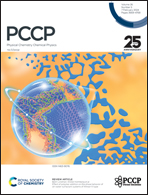Enhanced fluidity of water in superhydrophobic nanotubes: estimating viscosity using jump-corrected confined Stokes–Einstein approach†
Abstract
Accurately predicting the viscosity of water confined within nanotubes is vital for various technological applications. Traditional methods have failed in this regard, necessitating a novel approach. We introduced the jump-corrected confined Stokes–Einstein (JCSE) method and now employ the same to estimate the viscosity and diffusion in superhydrophobic nanotubes. Our study covers a temperature range of 230–300 K and considers three nanotube diameters. Results show that water inside superhydrophobic nanotubes exhibits a significantly lower viscosity and higher diffusion than those inside hydrophobic nanotubes. Narrower nanotubes and lower temperatures accentuate these effects. Furthermore, water inside superhydrophobic nanotubes display a lower viscosity than bulk water, with the difference increasing at lower temperatures. This reduction is attributed to weaker water–water interactions caused by a lower water density in the interfacial region. These findings highlight the importance of interfacial water density and its influence on nanotube viscosity, shedding light on nanoscale fluid dynamics and opening avenues for diverse applications.



 Please wait while we load your content...
Please wait while we load your content...